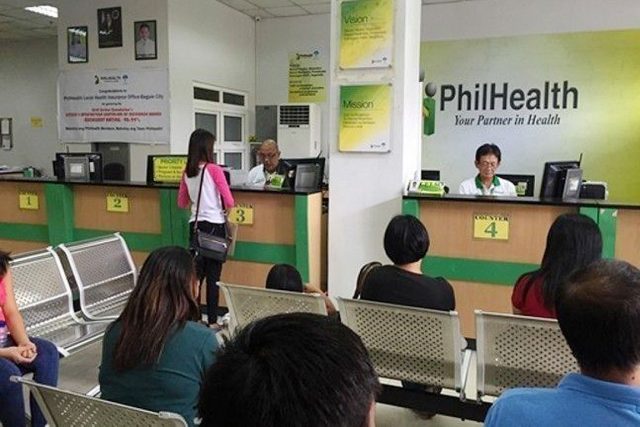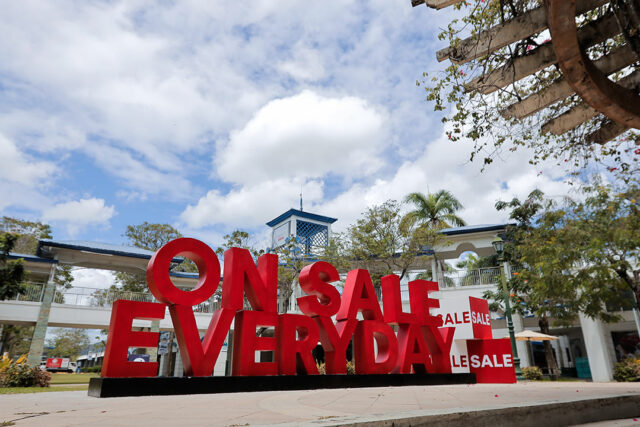US jobs data, Fed view to drive peso-dollar trading this week
THE PESO could move sideways against the dollar this week as the market reacts to key US labor data released on Friday that boosted expectations of another rate cut by the US Federal Reserve this month.
The local unit closed at P57.735 per dollar on Friday, strengthening by 14.5 centavos from its P57.88 finish on Thursday, Bankers Association of the Philippines data showed.
This was the peso’s best finish in more than six weeks or since its P57.59 close on Oct. 21.
Week on week, the peso jumped by 88.5 centavos from its P58.62 finish on Nov. 29.
“The dollar weakened following the release of US initial jobless claims and local inflation,” a trader said by phone on Friday.
Philippine headline inflation picked up to 2.5% in November from 2.3% in October, the government reported last week.
Still, this was slower than the 4.1% print in the same month a year ago and was within the central bank’s 2.2%-3% forecast for the month.
For the first 11 months, headline inflation averaged 3.2% in the 11-month period, a tad faster than the BSP’s 3.1% full-year baseline forecast but well within its 2-4% annual goal.
Meanwhile, the number of Americans filing new applications for unemployment benefits rose slightly in the last week of November, pointing to steadily easing labor market conditions heading into the final stretch of 2024, Reuters reported.
Initial claims for state unemployment benefits rose 9,000 to a seasonally adjusted 224,000 for the week ended Nov. 30, the Labor department said on Thursday. Economists polled by Reuters had forecast 215,000 claims for the latest week.
The data included the Thanksgiving holiday, which could have injected some noise into the report. Claims are entering a period of volatility, which could make it difficult to get a clear picture of the labor market.
The peso also continued to be supported by the seasonal increase in remittances from overseas Filipino workers amid the holidays, Rizal Commercial Banking Corp. Chief Economist Michael L. Ricafort said in a Viber message.
For this week, the trader said the foreign exchange market will react to the US nonfarm payrolls (NFP) data released on Friday.
“Softer NFP figures may encourage dollar selling, while a surprisingly stronger NFP may push the dollar-peso to P58,” the trader said.
The trader sees the peso moving between P57.50 and P58 per dollar this week, while Mr. Ricafort expects it to range from P57.25 to P57.85.
US job growth surged in November after being severely hindered by hurricanes and strikes, but a rise in the unemployment rate to 4.2% pointed to an easing labor market that should allow the Federal Reserve to cut interest rates again this month, Reuters reported.
The labor market’s resilience is driving the economy through strong consumer spending, with the closely watched employment report from the Labor Department on Friday showing solid wage growth last month. The economy created 56,000 more jobs in September and October than previously estimated.
Nonfarm payrolls increased by 227,000 jobs last month after rising by an upwardly revised 36,000 in October, the Labor department’s Bureau of Labor Statistics said. Economists polled by Reuters had forecast payrolls would gain 200,000 jobs following a previously reported rise of 12,000 in October.
Job growth averaged 173,000 per month over the past three months.
Financial markets see a roughly 89% chance of a quarter-percentage-point rate cut at the US central bank’s Dec. 17-18 policy meeting, up from 72% earlier, CME Group’s FedWatch tool showed. The Fed has lowered interest rates by 75 basis points since September, when it launched its easing cycle. Its policy rate is now in the 4.50%-4.75% range, having been hiked by 5.25 percentage points between March 2022 and July 2023. — A.M.C. Sy with Reuters
Stocks may extend climb on BSP rate cut hopes
PHILIPPINE STOCKS could climb further this week on hopes of further monetary easing by the Bangko Sentral ng Pilipinas (BSP) as the November inflation print was within market expectations.
On Friday, the Philippine Stock Exchange index (PSEi) rose by 0.57% or 38.37 points to close at 6,729.14, while the broader all shares index increased by 0.36% or 13.79 points to 3,790.68.
Week on week, the PSEi climbed by 1.74% or 115.29 points from the 6,613.85 close on Nov. 29.
“The local bourse shrugged off the slight uptick in domestic inflation, posting gains to end the week,” online brokerage firm 2TradeAsia.com said in a market note.
Philippine headline inflation picked up to 2.5% year on year in November from 2.3% in October, the government reported last week.
Still, this was slower than 4.1% in the same month a year ago and was within the BSP’s 2.2%-3% forecast for the month. The November print also matched the median estimate in a BusinessWorld poll of 15 analysts.
For this week, Philstocks Financial, Inc. Senior Research Analyst Japhet Louis O. Tantiangco said in a Viber message that the market could continue to rise amid improving sentiment, placing the PSEi’s support at 6,700-6,800 and resistance at 7,000.
“The market could move with an upward bias amid hopes that the BSP will further ease monetary policy. This comes as inflation is seen to remain under control based on the latest figures,” he said.
The Monetary Board will hold its last review for the year on Dec. 19. The BSP has cut benchmark borrowing costs by a total of 50 basis points (bps) since kicking off its easing cycle in August, bringing its policy rate to 6%.
“In addition, the local currency’s appreciation against the US dollar, if it continues, may give the market a boost,” Mr. Tantiangco added.
On Friday, the peso closed at P57.735 per dollar, strengthening by 14.5 centavos from its P57.88 finish on Tuesday, Bankers Association of the Philippines data showed. This was the local unit’s best finish in more than six weeks or since its P57.59 close on Oct. 21.
“Investors are also expected to watch out for the US’ upcoming November inflation numbers as these would give clues on the Federal Reserve’s policy outlook,” Mr. Tantiangco said. US consumer and producer inflation data will be released on Dec. 11 (Wednesday) and Dec. 12 (Thursday), respectively.
The Fed will hold its last policy meeting for the year on Dec. 17-18. Markets widely expect the US central bank to cut rates by 25 bps next week.
Meanwhile, Rizal Commercial Banking Corp. Chief Economist Michael L. Ricafort and 2TradeAsia.com put the PSEi’s support at 6,500 and resistance at 7,000.
“Local equities, fundamentally, are in a position of strength relative to counterparts in developed markets, common headwinds notwithstanding… Forces in the short-run are likely to maintain pressure on the PSEi, which may camp south of 7,000 until yearend,” 2TradeAsia.com said. — Revin Mikhael D. Ochave
Japan trade agreement overdue for review, trade department says
THE Department of Trade and Industry (DTI) said that the Japan-Philippines Economic Partnership Agreement (JPEPA) should be reviewed to account for developments in digital trade, among others.
At the National Exporters Weeks, Undersecretary Allan B. Gepty said an upgraded JPEPA may include rules and arrangements necessary to establish a resilient supply chain.
“(It may also) include a comprehensive chapter on digital trade, intellectual property, sustainable development, and even a forward-looking economic cooperation arrangement focused on innovation and technological development,” he added.
The JPEPA is the Philippines’ first bilateral free trade agreement (FTA), which entered into force in December 2008.
It covers trade goods, rules of origin, customs procedures, investment, movement of natural persons, intellectual property, and government procurement.
“Notably, this FTA has no provisions or elements relating to sustainable development, environment, e-commerce, or even the circular economy, which are critical in promoting sustainable trade and economic empowerment for our stakeholders,” he said.
“We can say that JPEPA is more focused on market access and the conventional rules and disciplines in conducting trade and investment,” he added.
Japan is the country’s third-largest export market and the third-largest source of imports. Total trade between the two countries amounted to $20.7 billion last year.
The Philippines’ top exports to Japan are digital monolithic integrated circuits, ignition wiring sets, and other wiring sets for vehicles, aircraft, or ships, bananas, nickel oxide sinters, and other vessels for the transport of goods and persons.
“Clearly, trade with Japan is anchored heavily on electronics and semiconductors. If the Philippines and Japan want to promote sustainable trade, I would say that it is imperative that we strengthen the supply chain for these key products,” he said.
“This means Japan should invest more in these sectors, especially product or design development and the production of high-technology-based products, especially as the Philippines positions itself now as a hub for smart and sustainable manufacturing,” he added.
Mr. Gepty said that the review of the JPEPA has been long overdue. Under the agreement, it was to have been reviewed after five years of implementation.
“I would like to stress that sustainability is not just about the environment. People also matter; thus, cooperation on talent and skills development means a forward-looking approach to sustainability,” he said.
“This is what the Philippines and Japan must do moving forward. This arrangement must be entrenched in an FTA or other international agreement. In fact, this will also complement Japan’s co-creation vision in Asia,” he added.
He said that the Philippines and Japan can also partner in food security and agriculture, particularly in developing Philippine agriculture to complement Japan’s own food security program.
“With the country’s proximity to Japan and through our strong collaboration, we can upgrade our JPEPA to include not just enhanced market access but clear, more transparent, and simplified sanitary and phytosanitary standards,” he said.
This will allow the two countries to trade agricultural products with ease, which may encourage more investment in agriculture.
The Philippines supplies agricultural products like bananas and other tropical fruits that are part of the basic diet of most Japanese.
Philippine exports of bananas to Japan currently enjoy tariff reductions in Japan of 8% and 18%, depending on the season.
“We want to reduce it to zero. We want to negotiate for its reduction. So that is what we are working on,” he said. — Justine Irish D. Tabile
‘Significant progress’ in Philippine road to nuclear energy
THE PHILIPPINES has made significant progress in its pursuit of nuclear energy, though further work is needed on its strategy, according to an assessment issued by the International Atomic Energy Agency (IAEA).
The IAEA concluded its Follow-Up Integrated Nuclear Infrastructure Review (INIR) on Dec. 6 at the request of the government.
In a statement last week, the IAEA said that the INIR mission team noted that the Philippines has made “significant progress to address most of the recommendations and suggestions and has adopted a national position for a nuclear energy program.”
In 2022, an executive order outlined the government’s support for the inclusion of nuclear energy in the power mix.
In September, the Department of Energy (DoE) unveiled a nuclear energy roadmap, which calls for commercially operational nuclear power plants by 2032, with at least 1,200 megawatts (MW) of capacity, gradually increasing to 4,800 MW by 2050.
The mission also noted the drafting of a comprehensive law, and strengthened capacities in human resource development, regulatory frameworks, radiation protection, radioactive waste management, and emergency preparedness and response.
“I thank the IAEA for its invaluable partnership and for conducting this objective and professional review, which underscores the Philippines’ commitment to adhering to global standards and best practices in nuclear infrastructure development,” Energy Secretary Raphael P.M. Lotilla said in a statement on Sunday.
“This collaboration strengthens our ability to adopt nuclear energy responsibly alongside renewable energy sources, driving us closer to our goal of inclusive and sustainable economic growth,” he added.
The mission team indicated, however, that further work is needed to complete necessary studies for future activities related to the electrical grid, industrial involvement, and national legislation.
In a separate statement on Sunday, the DoE said that the Philippines and the US have finalized the Guiding Document, which establishes a framework for regular and structured engagement in the energy sector.
“This document is designed to facilitate meaningful collaboration and ensure the effective development and implementation of joint programs,” the DoE said.
The two countries convened their second Energy Policy Dialogue last week, reinforcing their shared commitment to advancing energy security, expanding access, and accelerating the clean energy transition.
“At the core of these discussions is a shared focus on advancing the deployment of renewable energy technologies to reduce carbon emissions, modernizing and expanding energy transmission infrastructure to meet growing demand, and exploring nuclear energy as a potential option for electricity generation,” the DoE said.
The dialogue also tackled the need for access to financing, innovative technology, and resilient infrastructure to support a “just energy transition.” — Sheldeen Joy Talavera
PHL seeks $1-B World Bank loan for resilient agri
THE PHILIPPINES is seeking a $1-billion World Bank loan to boost agrifood productivity and resiliency in the face of challenges posed by climate change.
The proposed Philippine Sustainable Agriculture Transformation program aims to boost “agriculture and fisheries development by enhancing agrifood system resilience through climate-responsive strategies, diversification, supportive policies, and improved fiscal performance,” according to a World Bank loan document.
The project cost is expected to amount to $12.90 billion over 2025-2029. The World Bank will finance $1 billion while the government will provide P11.90 billion.
The Department of Agriculture (DA) hopes to begin the procurement process by July 2025.
The cost to the economy is estimated at P26 billion a year due to climate change, according to a report from the International Center for Tropical Agriculture and DA. The study had been commissioned by the World Bank.
The bank said climate change will decrease agricultural productivity in the Philippines by 9% to 21% by 2050.
During the three months to September, the value of production in agriculture and fisheries at constant 2018 prices fell 3.7% to P397.43 billion, the Philippine Statistics Authority said.
Tropical cyclones Kristine and Leon caused P9.81 billion in damage across 183,877 hectares of farmland, on lost production of 380,704 metric tons, according to the DA.
This was the first project undertaken by the government under the bank’s Program-for-Results (PforR) financing scheme. The World Bank said the PforR scheme uses a country’s institutions and processes and links the disbursement of funds directly to the achievement of specific program results.
“The PforR would particularly focus on the country’s rice-based cropping systems. This encompasses 1.9 million hectares and some 3 million farmers, which represent 37% of the country’s farmers and fisherfolk,” it said.
The DA’s plan to carry out the program is known as the Para sa Masaganang Bagong Pilipinas (MBP) 2024-2027 framework, it said.
Expected MBP outcomes are higher incomes for farmers through enhanced productivity growth and resilient natural resource and input use.
It also seeks to attract a “new generation of agri-entrepreneurs to invest in post-harvest agri-logistic activities and increase and diversify agri-food production across value chains.”
“The PforR would particularly focus on the country’s rice-based cropping systems,” the bank said, adding that this sector encompasses 1.9 million hectares and some three million farmers that represent 37% of all farmers and fisherfolk. — Aubrey Rose A. Inosante
GOCC subsidies increase 30.4% in October
SUBSIDIES provided to government-owned and -controlled corporations (GOCCs) rose 30.24% year on year in October, the Bureau of the Treasury (BTr) said.
The Treasury said budgetary support to GOCCs totaled P11.97 billion in October, up from P9.19 billion a year earlier.
Month on month, GOCC subsidies declined 34.30% from P18.22 billion in September.
State-owned firms receive monthly subsidies from the National Government (NG) to support their daily operations if their revenue is insufficient.
The National Irrigation Authority (NIA) was the top recipient in October with P5.83 billion, followed by the National Food Authority with P3 billion and the National Housing Authority with P1.73 billion.
GOCCs that received at least P200 million in subsidies included the Philippine Children’s Medical Center (P211 million), and the Philippine Heart Center (P168 million).
The National Kidney Transplant Institute (P133 million), the Philippine Fisheries Development Authority (P133 million), and the Philippine Coconut Authority (P112 million) also received subsidies.
At least P50 million in subsidies were given to the Light Rail Transit Authority (P72 million), Lung Center of the Philippines (P70 million), the Philippine National Railways (P62 million), and the Tourism Promotions Board (P60 million).
The Development Academy of the Philippines and Subic Bay Metropolitan Authority received subsidies of P57 million and P55 million, respectively.
State-owned corporations that received at least P20 million include the Philippine Rice Research Institute with P46 million, the Cultural Center of the Philippines with P38 million, the Center for International Trade Expositions and Missions with P38 million, and the National Dairy Authority with P21 million.
The Philippine Institute for Development Studies took in P21 million this month, and Aurora Pacific Economic Zone and Freeport Authority received P20 million.
Other subsidy recipients were the Metropolitan Waterworks and Sewerage System (P13 million), the Intercontinental Broadcasting Corp. (IBC)-13 (P12 million), the Bangko Sentral ng Pilipinas (P10 million), Credit Information Corp. (P5 million), and the Philippine Center for Economic Development (P3 million).
Other recipients were the Sugar Regulatory Administration (P10 million), the Philippine Institute of Traditional and Alternative Health Care (P9 million), the Southern Philippines Development Authority (P7 million), the Philippine Tax Academy (P5 million), the Zamboanga City Special Economic Zone (P4 million) and the Tourism Infrastructure and Enterprise Zone Authority (P3 million).
Not receiving subsidies for the month were National Home Mortgage Finance Corp., the Philippine Crop Insurance Corp., the Social Housing Finance Corp., the Small Business Corp., the Local Water Utilities Administration, the National Electrification Administration, the National Power Corp., the Bases Conversion and Development Authority, the Philippine Postal Corp., and the Power Sector Assets & Liabilities Management Corp. (PSALM), and the Philippine Health Insurance Corp. (PhilHealth).
In the 10 months to October, subsidies amounted to P117,21 billion, down 19.89% from a year earlier.
The National Irrigation Administration took in P60.21 billion or 51.37% of the total, followed by PhilHealth at P9.60 billion and the PSALM at P8 billion.
Rizal Commercial Banking Corp. Chief Economist Michael L. Ricafort said higher subsidies for GOCCs could be attributed to higher inflation since 2022, which increased their expenditures.
“Some profitable GOCCs were urged in recent months to remit more dividends to the National Government in an effort to mitigate additional new borrowing and in curb the growth in outstanding NG debt,” he said.
Outstanding debt rose 0.8% to P16.02 trillion at the end of October from P15.89 trillion a month earlier, the BTr said.
Zyza Nadine Suzara, executive director of think tank iLEAD said “the jump isn’t due to anything extraordinary.”
She added that the variability could be due to differences in the timing of releases since the Department of Budget and Management (DBM) releases the subsidies for some GOCCs depending on when they are requested.
“As for PhilHealth, their subsidies under the 2024 GAA (General Appropriations Act) might have been released earlier,” Ms. Suzara said.
Groups have sought to block the transfer of GOCC reserve funds beyond their dividend obligations, with the first P60 billion out of P89.9 billion remitted to the Treasury.
The Supreme Court delayed oral arguments on the fund transfers to Feb. 4 from Jan. 14. — Aubrey Rose A. Inosante
Retailers reject EDSA ban on mall-wide sales, urge MMDA to optimize schedule
THE Metropolitan Manila Development Authority (MMDA) needs to optimize the scheduling of mall-wide sales to ease road congestion on Epifanio de los Santos Avenue (EDSA) as an alternative to a blanket ban, the Philippine Retailers Association (said).
PRA President Roberto S. Claudio told BusinessWorld that the MMDA sale ban to be enforced on the 29 EDSA malls runs counter to the spirit of free enterprise and “deprives consumers of information about promotions this Christmas season.”
The MMDA has taken the position that only certain stores or outlets inside the malls should offer sales, which it said should not be mall-wide.
“The malls are willing to agree with coordination with MMDA on the scheduling of mall-wide sales,” Mr. Claudio said.
He floated the idea of two malls at a time scheduling mall-wide sales every three days.
“MMDA just wants to reduce the traffic problems that happen when mall-wide sales happen at the same time in many malls along EDSA,” he said.
According to the MMDA, the volume of vehicles traversing EDSA is currently at 464,000 daily, which is expected to increase to 480,000, with travel speed averaging 18 kilometers per hour by the third week of December.
Deliveries to malls are also only permitted between 11 p.m. and 5 a.m., with the exception of deliveries of perishable items. — Justine Irish D. Tabile
Philexport sees sustainability as $12-trillion potential market
THE Philippine Exporters Confederation, Inc. (Philexport) said exporters and manufacturers stand to tap a $12-trillion market by building sustainability into their businesses.
In a statement over the weekend, the group said a sustainability mindset will allow businesses to create new markets and expand current ones.
“They can unlock $12 trillion in business opportunities varying from industry and market by delivering on the United Nations Sustainable Development Goals (SDGs),” said Philexport President Sergio Ortiz-Luis, Jr.
“Working with a sustainability lens also enables companies to differentiate or build brands, penetrate new markets or new segments where sustainability matters, and develop new partnerships and sales channels,” he added.
He added that many investment funds and banks offer preferential terms to companies that align their activities with the SDG framework.
Aside from expanding markets, he said that exporters will need to comply with sustainability policies being imposed by the European Union (EU), the Philippines’ fourth-largest trading partner.
“It is estimated that the EU market represents a further $11 billion worth of unrealized export potential for the Philippines,” he added.
However, Mr. Ortiz-Luis said that the export targets under the Philippine Export Development Plan (PEDP) may be difficult to achieve amid new trade-restrictive measures on goods being imposed by G20 economies.
Citing the World Trade Organization, Philexport said that there are about 91 new trade-restrictive measures on goods introduced by G20 economies between mid-October 2023 and mid-October 2024.
These measures, along with geopolitical shifts, the effects of climate change, import regulations in key markets like the US and the EU, and inflation, can affect purchases of consumer goods, Mr. Ortiz-Luis said.
“Considering these developments, I believe that the ambitious targets set under the PEDP of $143.4 billion for this year and $240.5 billion by 2028 will somehow be adversely affected and difficult to achieve,” he added. — Justine Irish D. Tabile
ERC approves NGCP’s La Union-Ilocos Norte transmission project
THE Energy Regulatory Commission (ERC) approved a National Grid Corp. of the Philippines’ (NGCP) P20.65 billion transmission line connecting Balaoan, La Union to Laoag City.
The 500 kilovolt (kV) line forms part of the grid operator’s capital expenditure (capex) plan between 2020 and 2025 and beyond, according to the ERC.
The approval is subject to “optimization based on its actual use and verified expenses incurred during the reset process for the subsequent regulatory period.”
The ERC said that the transmission project is “one of the 15 proposed projects that will redound to the benefit of the electricity consumers in terms of continuous, reliable and efficient power supply” as required by the Electric Power Industry Reform Act of 2001.
Last month, the ERC said itapproved three transmission projects forming part of the capex plan amounting to P38.09 billion.
The grid projects are expected to improve the reliability and stability of the transmission grid in key provinces in Luzon and the Visayas.
The NGCP has said that it has earmarked more than P600 billio for over 100 transmission projects in the pipeline.
The grid projects form part of the Transmission Development Plan 2024-2050, which are “ready for implementation,” according to the company. — Sheldeen Joy Talavera
Guiding PHL SMEs through their cybersecurity journey
IN BRIEF:
• Attacks targeting small businesses are on the rise, and a single successful breach could jeopardize operations, customer trust, and business continuity.
• Rather than try to build a comprehensive security team from scratch — which can be prohibitively expensive — many small businesses are benefiting from “CISO-as-a-Service” models.
• This model allows companies to bring in experienced security professionals who offer strategic guidance, oversee critical cybersecurity activities, and provide access to a broader team of security specialists, all on a shared-service basis.
In the Philippines, small- and medium-sized businesses (SMEs) often face significant challenges when it comes to cybersecurity. With fewer than 20 IT personnel on staff, many organizations may only have basic protections — such as antivirus software programs and a firewall — in place. It’s common for these businesses to not have implemented services like Active Directory, and handle cybersecurity as an afterthought rather than a priority.
Yet, in today’s increasingly digital economy, these businesses are at risk. Attacks targeting small businesses are on the rise, and a single successful breach could jeopardize operations, customer trust, and business continuity. With that in mind, this article will discuss how Philippine SMEs with limited resources can embark on a cybersecurity journey that’s practical, achievable, and cost-effective.
OUTSOURCING FOR EFFICIENCY
One of the most effective approaches to cybersecurity for SMEs is to consider outsourcing cybersecurity functions. Rather than try to build a comprehensive security team from scratch — which can be prohibitively expensive — many small businesses are benefiting from “CISO-as-a-Service” models.
A Chief Information Security Officer (CISO) as a service allows SMEs to access top-tier security expertise without having to hire full-time specialists. Through this model, companies can bring in experienced security professionals who offer strategic guidance, oversee critical cybersecurity activities, and provide access to a broader team of security specialists, all on a shared-service basis. This reduces costs while still ensuring that the business benefits from industry best practices.
THE CYBERSECURITY JOURNEY
Assess current state. Begin by assessing the current capabilities of the company. Understand what assets must be protected, identify any existing vulnerabilities, and evaluate all current tools and configurations. An outsourced partner can help facilitate this process, providing an unbiased, thorough review of the company’s security posture.
Focus on the fundamentals. For organizations that have limited resources and basic tools, starting with strong foundational controls is key. This includes the following:
• Endpoint Security: Go beyond simple antivirus programs by considering endpoint detection and response (EDR) tools. These can provide more visibility into potential threats and help respond to attacks quickly. Choose EDR solutions that are simple to deploy and have an intuitive interface, making them easy for the IT team to manage.
• Network Segmentation and Firewalls: Reinforce the company’s firewall setup and consider segmenting its network. This way, even if attackers gain access to one part of the system, they won’t be able to move freely. Look for firewalls that offer user-friendly dashboards, allowing the IT team to easily understand and manage network activity.
Prioritize identity and access management. Many SMEs may not have any form of identity management system in place. Implementing a cloud-based solution, such as a simple single sign-on (SSO) or even managed identity access solutions, can significantly reduce risk. These solutions simplify login processes for users while enhancing security. An outsourced partner can make these systems easy to deploy and manage, reducing the burden on the internal team.
Embrace managed security services. As part of the company’s journey, outsourcing Managed Detection and Response (MDR) can be particularly valuable. Managed service providers have dedicated security operations centers (SOCs) and can monitor the company network 24/7 for suspicious activity — something most SMEs can’t do on their own. The MDR tools often come with simplified reporting and alerts that are easy for the internal team to understand, ensuring that even non-specialist staff can grasp the current security state.
Employee awareness and training. Many attacks target employees through phishing or social engineering tactics. Implement regular training sessions for company employees to teach them how to recognize threats. This is also something that a managed partner can easily help facilitate. Look for training programs that are interactive and easy to understand, ensuring employees find them engaging rather than overwhelming.
Adopt user-friendly security controls. One concern that often arises when discussing cybersecurity is that it may hinder productivity. However, many of today’s solutions focus on enhancing both security and usability. Multi-Factor Authentication (MFA), for example, may seem like an extra step, but when integrated properly, it makes logging in faster while also being more secure. Choose MFA tools that are simple to use and integrate seamlessly with the company’s existing systems. Prioritize tools that simplify administration and are transparent to users, ensuring security isn’t seen as a burden but rather as an enabler of efficient work.
BENEFITS OF OUTSOURCING CYBERSECURITY
Cost efficiency. Rather than investing in full-time employees and costly infrastructure, outsourcing enables paying only for what the company needs, when it is needed.
Access to expertise. Cybersecurity is complex and constantly evolving. Partnering with a provider provides access to specialists who are on top of the latest threats and trends.
Scalable solutions. Outsourcing allows the scaling of security capabilities as the business grows, meaning companies do not have to worry about outgrowing their protections.
Faster implementation. Leveraging external resources means that new security controls can be implemented faster, helping the business reach an improved level of security in weeks, rather than months or years.
TRANSFORMING SECURITY FOR GROWTH
As an example, a medium-sized business had started with just an antivirus program and a basic firewall. It began its cybersecurity journey by gradually adopting outsourced cybersecurity services, such as MDR and a CISO-as-a-Service. Over time, it was assisted in implementing more sophisticated controls — including endpoint detection, identity management, and cloud security. While its footprint is small compared to global organizations, its level of protection is now at par with international standards.
Throughout the journey, the service provider kept a focus on ease of administration and usability. The goal of the journey wasn’t just to make the organization more secure but also to make it easy for employees to operate securely — resulting in a more productive and safer environment for everyone.
BEGINNING THE CYBERSECURITY JOURNEY TODAY
The path to cybersecurity doesn’t have to be overwhelming. By outsourcing key functions, adopting best practices step by step, and focusing on tools that blend security with usability, SMEs can more effectively protect themselves without overextending their resources.
Remember, it’s not about where the company starts — it’s about taking that first step towards securing the business for the future.
This article is for general information only and is not a substitute for professional advice where the facts and circumstances warrant. The views and opinions expressed above are those of the author and do not necessarily represent the views of SGV & Co.
Carlo Kristle G. Dimarucut is a technology consulting partner of SGV & Co.
Philippine bribery hurts MSMEs most; gov’t urged to fast-track digital push
By Kyle Aristophere T. Atienza, Reporter
THE PHILIPPINES remains highly vulnerable to bribery due to the slow rollout of its digitalization program, an industry group said, warning that it prevents small businesses from entering the formal economy.
Despite key developments in the country’s fight against corruption, the problem of bribery persists mainly due to the slow digital transformation push, Philippine Chamber of Commerce and Industry (PCCI) President Enunina V. Mangio said.
“Digitalization efforts have been slow as the infrastructure is still incomplete,” she said in a Viber message. “Perception is still strong that bribery is necessary for securing basic services or for businesses to operate.”
She said businesses usually encounter bribery in securing permits and licenses both at the national and local levels, in dealing with Customs and tax authorities, and in resolving disputes with government contractors.
Ms. Mangio said bribery raises the cost of doing business especially for micro, small and medium enterprises (MSMEs), which account for over 99% of businesses in the Philippines, because they lack the resources to deal with corrupt practices.
“It holds back the growth of enterprises, especially the nano- (cottage) and micro-enterprises that seek to enter the formal economy,” she said. “It deters market competition as only those with enough resources have the capacity to pay off agencies, officials and employees.”
“This leads to higher cost of goods and services and hinders the growth of innovation.”
The Philippines rose eight spots to 111th out of 194 countries in the 2024 edition of the Bribery Risk Matrix by nonprofit business group TRACE.
While the country’s ranking improved, its overall score fell two points from 54 in the 2023 edition, where the country ranked 119th. The country kept a “moderate risk” level of bribery.
The Philippines got the highest score in deterrence risk at 75. It received a score of 50 in opportunity risk, 49 in transparency risk and 44 in oversight risk.
Ms. Mangio noted that efforts to curb bribery and other corrupt practices have generally been limited to digitalizing frontline government processes to reduce face-to-face interactions.
Some of the key reforms that may help the country deter bribery include the creation of an Office of the Special Presidential Assistant for Economic and Investment Affairs and Private Sector Advisory Council, and setting up green lanes for strategic investments under a presidential order, she noted.
“Armed with a direct mandate from the President, they are effective and formidable allies of the private sector in the fight against bribery and corruption.”
Ms. Mangio also noted that the Department of Interior and Local Government’s Seal of Good Local Governance “has been instrumental in upholding transparency and accountability among local governments and in incentivizing good performance.”
The PCCI called for the integration of digital payment in all government services, noting that it should “cover all national and local government agencies and their instrumentalities.”
It sought the passage of a whistleblower protection law “to encourage reporting of corrupt practices without fear of retribution.”
The PCCI said the government should fast-track the creation of online platforms for government contracts, spending and procurement.
The government should also provide the Office of the Ombudsman, Commission on Audit and Philippine Anti-Corruption Commission with better resources and staff training, while giving them “political independence” to be free from interference.














